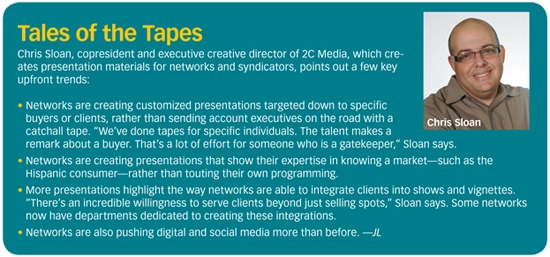

Challenge for Networks Is to Create More Memorable Upfront Presentations for Marketers
Upfront presentations are evolving into dynamic, strategic events blending entertainment and data to secure billions in advertising dollars.
By Jon Lafayette
It’s Only January, But It’s Already Upfront Time
It’s only January, but it’s already upfront time for the people who put together the presentations designed to lure the $18 billion in advertising dollars that media buyers will parcel out starting in late May for the 2012-13 season.
Network execs are assembling reams of research, culling clips from shows, and looking for ways to make their massive strategy plays interesting and original—even unforgettable—to buyers who have seen it all many times before. Some presentations will be aimed at a single buyer or client, while others will be shown in giant venues like Radio City Music Hall. As CBS chief Leslie Moonves likes to remind us every year at his May presentation in the historic venue: “How do you get to Carnegie Hall? Practice, practice, practice.”
“Media buyers have seen hundreds of these presentations. You have to make your stuff stand out and be very entertaining and memorable,” says Andy Baker, VP and creative director at National Geographic Channel. “Make them smile. Make them get a goose bump. Really wow them. I’ve worked on upfront every single year for the last 10 or 11 years, so I’ve learned a little lesson in each along the way.”
“In terms of the day-to-day, it’s probably front-of-mind about six to eight months of the year,” says Patrick Trettenero, creative director at USA Network. “And the rest of the year, we’re either analyzing what we just did or starting to think about what we’re going to do the next year.”
Buyers Getting into Upfront Mode
Buyers are also getting into upfront mode.
“We’re getting to around that time in late January where people are starting to think a little bit about, ‘Hey, it’s going to be upfront pretty soon,’” says Gary Carr, senior VP and executive director of national broadcast at Targetcast. “Within the next month or two, we’re going to have to make presentations to our clients talking about where we see the market. That’s what’s going on right now.”
New tactics are already at work. This year, networks are waiting until March before holding events. During the past two years, MTV was among the early birds, putting on a show last February at the Hammerstein Ballroom featuring music by Bruno Mars. The network, struggling at the time, wanted an uncluttered moment to explain its new strategy to buyers. Now, with ratings up, MTV will step up to the plate in late April to be more in the thick of things.
Some networks, like NatGeo, will hold meetings with individual agencies and clients and forgo a major event. Others, like FX, will focus on fun, inviting buyers for a night of bowling with the network’s talent. Many networks will rent out a restaurant, a loft, a theater, or an arena to put on a show while delivering their sales message in a way that entertains clients.
Cable Networks Go Big
As ratings and ad revenue for cable networks have grown, their presentations have become more elaborate. Top-rated cabler USA Network will hold an event during what has traditionally been the broadcasters’ week (this year starting May 14), joining Turner Broadcasting and ESPN.
“More and more cable networks are doing lavish presentations at nice venues with entertainment,” Carr says. “Those networks get a lot of money. They’re getting billions in sales, and they’re putting on better and better shows. They’re taking some of that primetime money.”
Broadcasters Are Baaaack
As for the broadcast networks, they cut back during the recession but are now also partying like it’s 1999. NBC, which stopped doing big presentations in 2008 and 2009, put on a full-scale schedule presentation last year on Monday morning of upfront week, followed by a luncheon with its stars in attendance. NBC has not disclosed its 2012 plans.
Fox takes its swings after NBC on Monday afternoon, followed by a big party in Central Park Monday evening. ABC will gather buyers at Lincoln Center on Tuesday afternoon for its presentation, but has been known to host an afterparty for only its biggest buyers and clients.
“For someone who does what I do, it’s important to be presented with the schedule and know what the programming is going to look like,” says Chris Geraci, president of national broadcast at OMD. “I still think that it’s a pretty efficient use of one or two hours.”
The Evolving Strategy
Chris Sloan, copresident and executive creative director of 2C Media, which creates presentation materials for broadcast and cable networks, notes that networks have become much more strategic.
“In the old days, they would spend $300,000 on these gigantic song-and-dance pieces,” Sloan says. “It’s a different age. There’s just so much more accountability now, and the economy’s obviously played a part of it.”
“Our first couple of years, as we were introducing the brand and the channel, we had to work really hard on the sales points and giving data of why they should advertise,” says NatGeo’s Baker. “Now our sales team says let’s tell great stories and show our great visuals because we believe that when people see the great shows, they’re just going to want to buy us.”
What Makes a Successful Upfront Presentation?
So, what makes an upfront presentation successful?
“You can’t do anything that’s old-fashioned and corny and feels like your father’s upfront,” says Trettenero. “These days, the buyers are hipper and younger than the network’s audience.”
Music plays an important role. “We’ve always worked really hard to make sure the music we’re creating is unique and different and connects back to the brand,” says Baker. However, avoiding clichés is crucial. Buzzwords like “transmedia” were overused last year to the point of losing meaning.
Humor, particularly self-deprecating humor, is also effective. Trettenero notes that Jimmy Kimmel’s evisceration of ABC during upfront presentations often resonates with buyers.
NatGeo’s Baker highlights the trend of moving printed materials to digital platforms. Websites with games, prizes, and other incentives are increasingly common.
Finally, brevity is key. Buyers and network executives agree that short and impactful presentations are often the most successful.
Subscribe To My Newsletter
BE NOTIFIED ABOUT MY ACTIVITIES, FOUNDATION AND RELEASES.
By subscribing to our mailing list, you agree to receive periodic emails from us and understand that your email address will not be shared and that you may unsubscribe at any time.


